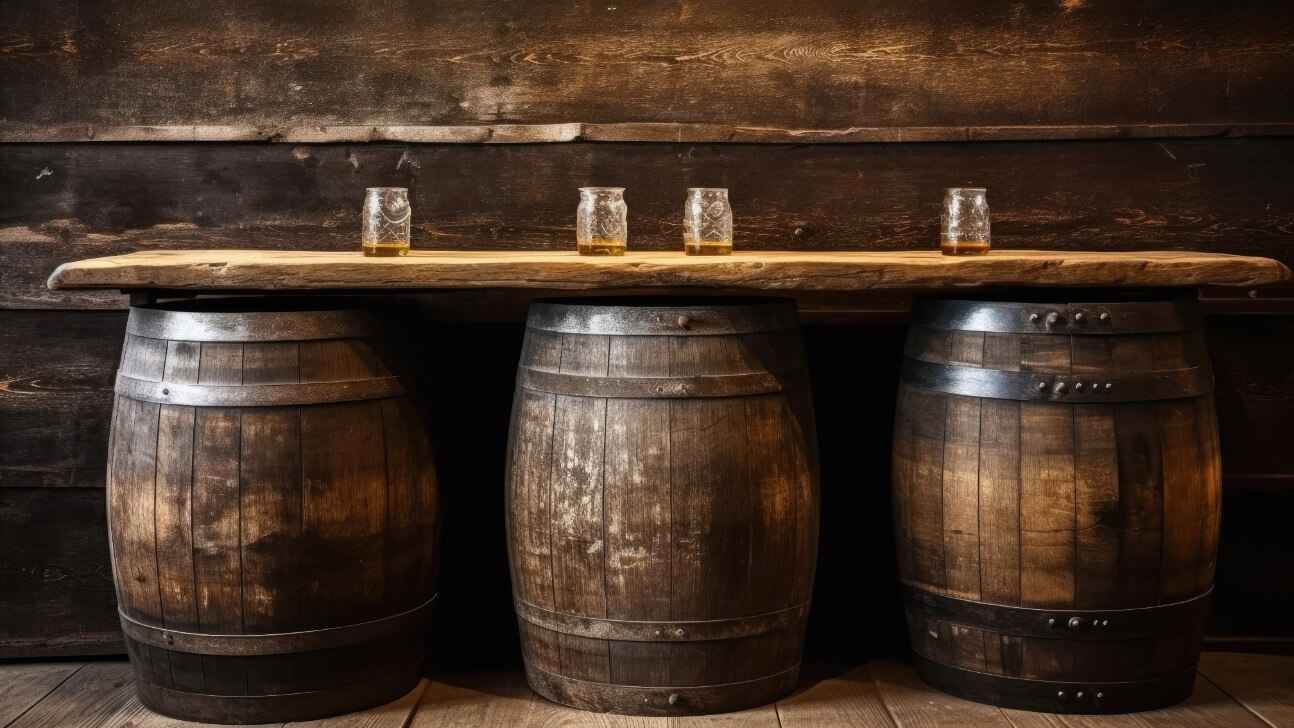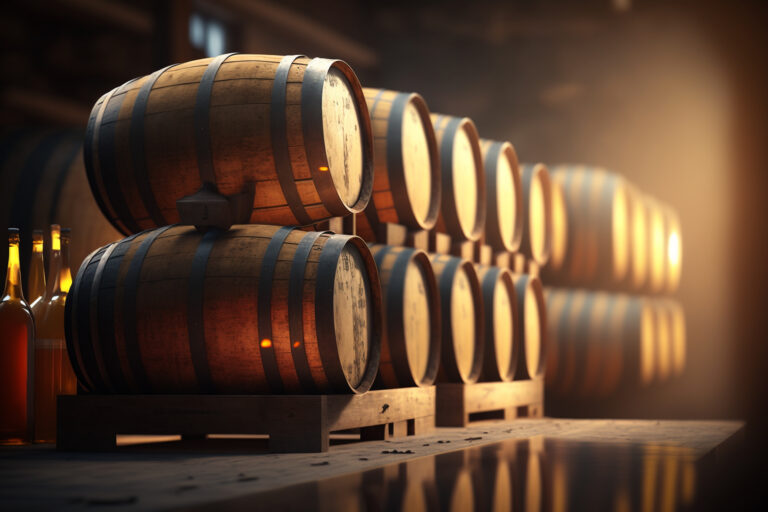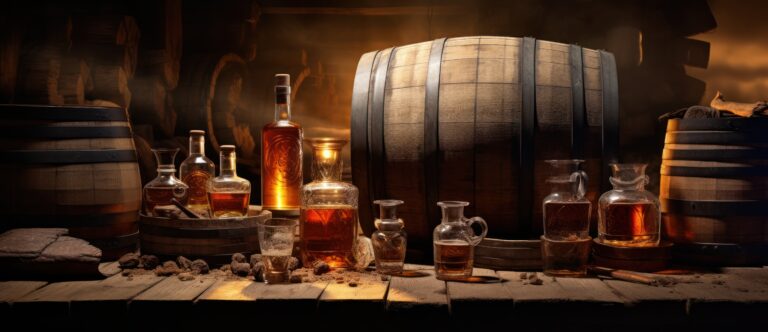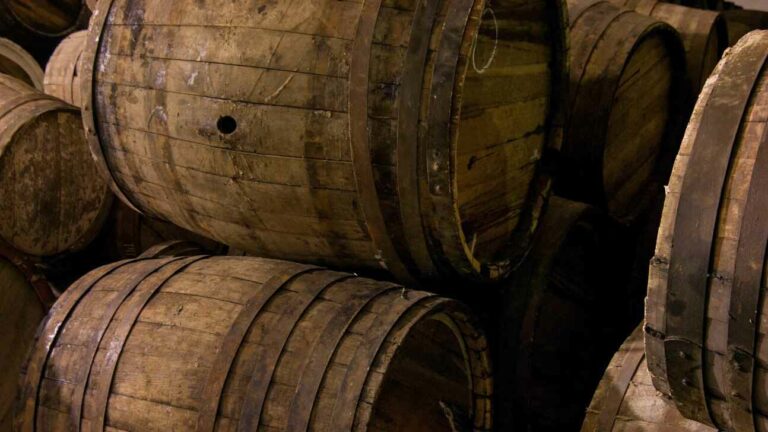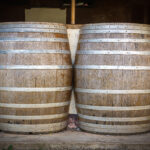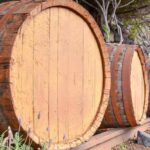Ever wonder what happens to those oak barrels after aging your favorite whiskey? Turns out, those barrels play an important role in sustainability. Once a distillery is done aging their spirits in the barrels, the wood is repurposed in innovative ways.
You’ve probably enjoyed a glass of bourbon or Scotch at some point. But did you know those oak barrels are essential for giving the liquor its distinctive taste and color? The wood expands and contracts with the changing temperatures, allowing the liquid to seep deeper into the wood, extracting more flavor compounds. Distilleries can only use barrels a few times for aging before the wood gets too saturated.
So what happens to the barrels next? Many find a second life, getting used in creative ways that reduce waste and benefit the environment. From furniture and flooring to landscaping and construction, spent barrels are fueling sustainable industries in surprising ways. Next time you sip a glass of whiskey, know that those same barrels continue enriching lives even after their aging days are done. The story of the whiskey barrel is a story of sustainability, with an ending that keeps on giving.
The Life Cycle of a Whiskey Barrel
The life cycle of a whiskey barrel begins in the forest, where oak trees are harvested and cut into staves that are shaped into barrels. Once assembled, the barrels are toasted and charred, which helps impart flavor to the whiskey during aging.
Distillers then fill the barrels with new whiskey distillate, usually containing 60-70% alcohol by volume, commonly called “white dog.” Over time, the whiskey interacts with the barrel, extracting flavors from the wood like vanilla, caramel and spice. As the whiskey breathes in oxygen through the barrel, its alcohol level drops and complex flavors develop.
The Aging Process
The aging period, often 3 to over 50 years, is critical. As the whiskey ages, its color darkens and flavors become more complex. The alcohol content also decreases through evaporation, a process known as “angel’s share.” After aging, the barrel is emptied, and the mature whiskey is bottled.
Some barrels are then refilled and used to age more whiskey, while others are recycled. Barrels that imparted flavor to bourbon whiskey may age scotch or rum. Spent barrels are also upcycled into furniture, planters, and other products.
Nothing goes to waste in the whiskey barrel life cycle. From growth to final use, barrels contribute to sustainable practices through renewable wood, re-use, and upcycling. By appreciating how barrels enhance whiskey and the environment, we gain a deeper understanding of this time-honored tradition. Sustainability, like a good whiskey, gets better with age.
Reusing Whiskey Barrels Supports Sustainable Forestry
Reusing whiskey barrels is a sustainable practice that supports responsible forestry. Barrel makers source oak from forests managed for longevity. As barrels are reused, the demand for new oak is reduced.
Cooperages Choose Oak Wisely
Cooperages that produce whiskey barrels carefully select oak species that are sustainably harvested. They choose oak types like American white oak that grow quickly and abundantly. These oaks can produce quality wood for barrels within 80-100 years.
Barrels Used for Decades
High-quality whiskey barrels can be used for 3-5 decades before retirement. As barrels age and mellow, they impart subtle flavors and aromas to the whiskey. Master distillers determine when barrels should be replaced based on their impact on flavor and aroma. Reusing barrels reduces waste and demand for new oak.
Retired Barrels Repurposed
When barrels are retired from aging whiskey, they aren’t discarded. Instead, many find new life as furniture, crafts, planters, and more. Some barrels return to cooperages to be reassembled as decorative items. Repurposing and reusing retired barrels further increases their sustainability.
A Virtuous Cycle
The lifecycle of whiskey barrels embodies a sustainable system. Oak from responsibly managed forests provides material for barrels. Barrels age whiskey for decades before being repurposed. At end of life, oak pieces are recycled into mulch, animal bedding, and biofuels. This virtuous cycle supports sustainable forestry and reduces waste, all while producing a timeless spirit.
Raising a glass of fine whiskey aged in reused barrels lets you savor sustainability with every sip. The conscientious practices behind whiskey barrels deserve a toast of their own.
Whiskey Barrels Repurposed for Beer Aging
Whiskey barrels that were once used to age spirits are finding new life aging craft beers. Brewers have discovered that repurposing used barrels imparts complex flavors and aroma compounds to their beers that are hard to achieve otherwise. It’s a sustainable practice that benefits both industries.
Added Flavor
When whiskey is aged in charred oak barrels, the wood absorbs and infuses the spirit with distinctive flavors like vanilla, caramel, and smoke. These barrels still hold traces of those flavors after the whiskey is bottled, which are then imparted to the beer during aging. The results are beers with layered, woodsy notes that craft beer fans go wild for. Many brewers use barrels from bourbon, rum or wine to create uniquely flavored brews.
Cost Effective
For small craft brewers, buying new oak barrels can be expensive. Repurposing used barrels from distilleries and wineries is an affordable way for them to age their beers. The barrels are usually sold at a steep discount since they’ve already been used once. Brewers simply clean, inspect and re-char the inside of the barrels before filling them with beer.
A Sustainable Practice
Reusing whiskey barrels is an environmentally friendly practice. Instead of being discarded after a single use, barrels are given a second life, reducing waste. And by avoiding the need to produce as many new barrels, it helps limit deforestation from oak tree harvesting. It’s a win-win situation for barrel makers, distillers, brewers and the planet.
Aging beer in used whiskey barrels has become popular for good reason. It leads to uniquely flavored beers, saves brewers money, and helps support sustainability. So the next time you sip a barrel-aged beer, you can feel good knowing that in a small way, you’re helping reduce environmental impact, one swig at a time.
Whiskey Barrels Upcycled Into Furniture and Decor
Whiskey barrels are often upcycled into rustic home decor and furniture. Once a barrel has been used to age whiskey, the wood takes on beautiful warm tones and the barrel shape lends itself well to repurposing. Upcycling barrels is a sustainable practice that reduces waste and gives the wood a second life.
Barrel Tables and Chairs
A popular upcycle for used whiskey barrels is transforming them into tables, chairs, stools and benches. The curved barrel shape provides an organic seating space and the distressed wood adds visual appeal. Some companies source authentic barrels from distilleries to craft into furniture. Others use reclaimed wood from barrels to construct new pieces with a rustic barrel flair.
Wall Decor
Barrel staves (the curved wood planks that make up the barrel) are frequently used to create wall art and rustic signs. The wood is cut to size, sanded and finished, then used as a canvas for stenciling or freehand artwork. Alternatively, the natural wood grain and aging marks are left exposed for a raw, textured look. Barrel hoops (the metal rings that hold the staves together) are also used in wall decor, turned into mirrors, candle holders, or left as-is.
Planters and Storage
Don’t throw out those barrel bottoms! Barrel bases make perfect planters, storage bins, ice buckets or trash cans. The open cylinder shape works well for corralling items or displaying plants and decor. Some barrel bases are outfitted with casters so they can be rolled from place to place.
Other popular upcycles for used whiskey barrels include:
- Lighting fixtures
- Cabinet knobs/handles
- Entryway organizers
- Pet food storage
- Firewood holders
By finding a second life for whiskey barrels through upcycling into home decor or furniture, these timeless icons of bourbon-making live on and continue to be appreciated. An upcycled barrel piece is a great way to bring warmth and rustic character into any space.
Charring Oak for Whiskey Boosts Carbon Sequestration
The charring of oak barrels used for aging whiskey contributes to sustainability in several ways.
Carbon Sequestration
When oak barrels are charred, it locks in carbon that was once in the atmosphere as carbon dioxide. The char layer acts as a barrier, trapping the carbon within the barrel. Studies show charred oak barrels can sequester up to 5 kilograms of carbon per barrel.
As the whiskey ages, more carbon is absorbed into the liquor. The longer the aging process, the more carbon is sequestered. Many distillers use barrels multiple times before replacing them to maximize carbon capture. Some estimate the total carbon sequestered during the full lifecycle of an oak barrel at 10-15 kilograms per barrel.
Using oak barrels in this way helps reduce greenhouse gas emissions and the overall carbon footprint of whiskey production. It’s an easy way distillers can act sustainably while also improving their product.
Barrel Reuse and Recycling
Rather than discarding used barrels, many distillers re-char and reuse them several times for aging whiskey. When barrels are spent, they are often recycled into furniture, flooring, and other wood products. Some are even upcycled as planters, rain barrels, and containers.
This reuse and recycling further reduces the environmental impact of the whiskey industry. What was once a single-use commodity becomes a sustainable resource with many useful applications.
Supporting Oak Forests
The oak barrel industry supports sustainable forestry practices. Oak trees are a renewable resource, and regulations require distillers to source barrels from certified sustainable forests. For each tree harvested, several more are planted to regrow the forest.
Using oak barrels in whiskey production, especially when maximizing their use and recycling them, helps support sustainable business practices all along the supply chain. So the next time you sip an aged whiskey, you can feel good knowing each barrel does its part for the planet.
Innovative Uses for Spent Grain From Whiskey Making
Innovative Uses for Spent Grain From Whiskey Making
The leftovers from whiskey production don’t have to go to waste. Distilleries have found creative ways to recycle spent grain, the leftover mash from fermentation, into sustainable products.
After the yeast has converted the starch from malted barley into alcohol, the leftover grain mash contains protein, fiber, and nutrients that can be used as animal feed or compost. Many distilleries donate spent grain to local farmers to use as nutritious feed for cattle, pigs, and chickens. The grain mash can also be composted and used as fertilizer for crops.
Some distilleries have taken recycling spent grain to the next level. They’ve developed innovative products from the leftover mash that people can use and enjoy.
- Spent grain flour: The leftover grain mash is dried and milled into a nutritious flour that’s great for baking bread, cookies, and other goods. Spent grain flour adds protein, fiber and a malted flavor to recipes.
- Spent grain crisps and crackers: The dried grain mash is mixed into dough and baked into crunchy snacks, a sustainable way to use a distillery byproduct.
- Spent grain dog treats: Dried spent grain, sometimes mixed with other ingredients like peanut butter or pumpkin, is shaped into all-natural dog biscuits and treats.
- Spent grain body care: The oils from malted barley in spent grain have natural skin-nourishing properties. Some distilleries infuse the oils into lotions, soaps, and bath products.
By finding ways to reuse spent grain that would otherwise go to waste, whiskey distilleries are boosting their environmental sustainability and supporting local communities. The next time you sip a glass of whiskey, you can feel good knowing the leftover mash likely didn’t go to waste. Every barrel and every grain counts when it comes to sustainability.
Water Conservation Efforts at Whiskey Distilleries
Whiskey distilleries are increasingly focusing on sustainable practices, especially when it comes to water usage. The whiskey-making process requires large volumes of water, so conservation efforts are critical. Many distilleries have implemented innovative solutions to reduce their environmental footprint.
Recycling Graywater
Graywater refers to wastewater from sinks, showers, and washing machines – it’s gently used and still reusable. Several distilleries have systems in place to capture graywater, treat it, and reuse it for tasks like barrel cleaning, irrigation, and cooling towers. This helps cut down on the total amount of fresh water needed for operations.
Closed-Loop Cooling
Traditional cooling towers evaporate huge amounts of water. Closed-loop cooling systems recirculate the same water instead of constantly needing fresh intakes. The water is chilled and then recirculated to condense alcohol vapors after distillation. Some systems can recycle over 99% of the water used.
Rainwater Harvesting
Collecting rainwater is an easy way for distilleries to supplement their water supply in an eco-friendly manner. The rain is gathered from rooftops and stored in cisterns for use in the distillery. The soft, pH-neutral rainwater is ideal for whiskey production and helps preserve local freshwater sources.
Wastewater Treatment
State-of-the-art wastewater treatment facilities allow distilleries to clean and reuse wastewater multiple times before discharge or treatment. Anaerobic digesters break down organic waste and generate biogas for energy. Reverse osmosis, microfiltration, and other technologies produce near potable-quality water for use in boilers, cooling towers, and barrel cleaning. These advanced systems significantly slash the amount of wastewater generated during whiskey-making.
Progressive distilleries worldwide are taking innovative approaches to curb their environmental impact through enhanced water efficiency and conservation. Their efforts highlight how sustainability and spirit production can work hand in hand. By valuing this precious natural resource, distillers are able to craft award-winning whiskeys that don’t cost the earth.
How Whiskey Makers Power Operations With Renewable Energy
Many whiskey distillers are finding ways to operate more sustainably. One of the most impactful ways is by using renewable energy sources to power their operations.
Solar Power
Some distilleries install solar panels to harness the energy of the sun. The panels capture sunlight and convert it into electricity that powers equipment and facilities. Any excess solar energy is sent to the local utility grid. Using solar power reduces dependence on fossil fuels and lowers energy costs in the long run.
Water Conservation
Distilleries also focus on conserving water, an essential ingredient in whiskey making. They recycle water used for cooling and cleaning equipment and reuse it for other purposes like irrigation. They also use rainwater catchment systems to collect rainwater and use it for various applications. These water conservation methods significantly cut down on water usage.
Waste Reduction
Whiskey makers aim to reduce waste in their operations. They recycle materials like glass, paper, and plastic and compost organic waste. They also reuse whiskey barrels, an iconic symbol of whiskey making. After aging whiskey, the barrels are sold to age other spirits like rum, tequila, and wine or are repurposed for decorative and practical uses. Reusing barrels reduces deforestation and waste.
Sustainable Ingredients
Some distilleries source local, organic ingredients for their whiskies like barley and rye. Locally-sourced grains reduce the carbon footprint of transporting ingredients over long distances. Organic grains are grown using environmentally-friendly methods that don’t rely on chemical pesticides and fertilizers. Sourcing sustainable ingredients helps support local communities and a healthier environment.
By harnessing renewable energy, conserving natural resources, reducing waste, and using sustainable ingredients, whiskey makers can craft their spirits in an environmentally-friendly way. Their eco-conscious efforts make a huge difference in promoting sustainability.
Future Outlook: Whiskey Barrels and Sustainability
The whiskey barrel aging process contributes to sustainability in several ways. As demand for aged spirits increases worldwide, whiskey makers are finding innovative ways to boost production in an environmentally-friendly manner.
Repurposing Barrels
Once whiskey has been aged, the barrels are typically discarded. However, many distilleries are finding new uses for these barrels and repurposing them. Some are used as decor in restaurants or retail stores. Others are crafted into furniture like tables, stools or decorative items. A few innovative companies are even using old whiskey barrels to make musical instruments like guitars.
Fuel and Mulch
Some distilleries shred used barrels into wood chips that can be used as mulch in landscaping or as fuel for heating buildings. The wood from barrels is dense and high in lignin, making it an excellent renewable energy source. Using wood chips in this way reduces the distillery’s dependence on fossil fuels.
Composting
A handful of whiskey makers now compost discarded barrel staves, turning them into nutrient-rich compost or potting soil. The compost is then used as fertilizer in the distillery’s gardens or sold to local gardeners and farmers. This sustainable practice reduces waste and enriches the soil.
Experimenting with Alternative Woods
A few innovative distilleries are experimenting with aging whiskey in barrels made of woods other than traditional oak, such as maple, hickory or pecan. Using alternative woods provides more variety in flavor profiles and increases the sustainability of barrel-aging practices. However, these woods are often more difficult and expensive to source.
The whiskey industry’s shift toward sustainable practices like reusing barrels, reducing waste, and experimenting with eco-friendly materials points to a greener future for this time-honored spirit. While staying true to tradition, distillers worldwide are embracing more sustainable methods of production. The outlook is bright for environmentally-conscious whiskey lovers everywhere.
Final Thoughts
So there you have it, a look at how whiskey barrels support sustainability in more ways than one. Those charred oak barrels don’t just age spirits to perfection, they have an amazing second life that reduces waste and helps the environment. From flavoring hot sauces and maple syrups to building furniture and crafts, used barrels find new purpose. And through programs like the Bourbon Barrel Project, they provide affordable housing materials and help communities in need. The next time you sip a glass of bourbon, know that those oak notes come from an age-old tradition that’s pretty sustainable. Bottoms up!
